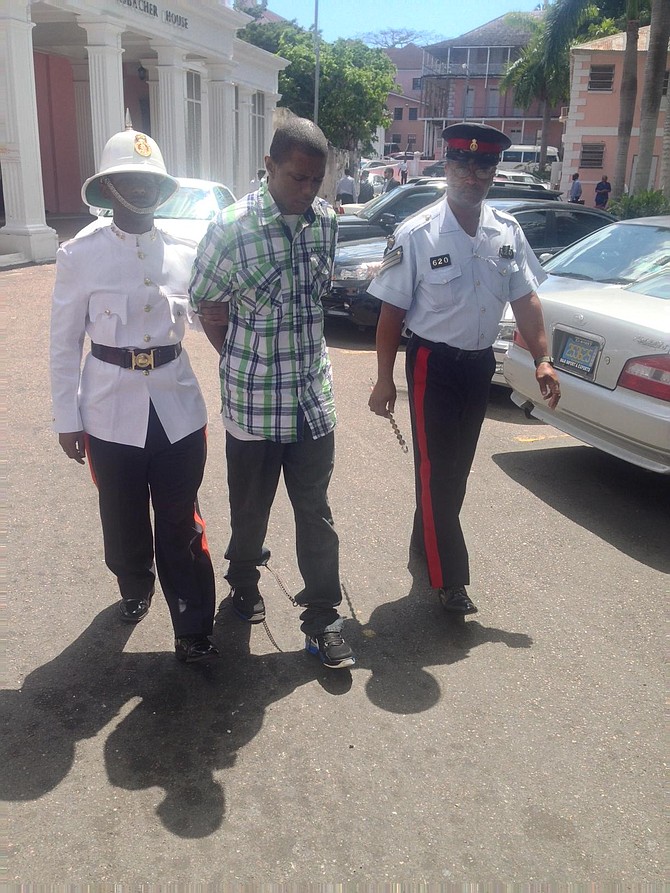By LAMECH JOHNSON
Tribune Staff Reporter
ljohnson@tribunemedia.net
THE lead investigator into the fatal stabbing of the teenage son of convicted drug traffickers Dwight and Keva Major testified yesterday about his questioning of a man arrested in connection with the incident.
Sergeant Jamal Evans of the Central Detective Unit said that on June 3, 2014, he was made aware that Kervin Neely was in a holding cell at CDU.
He went to the cell and informed Neely that he wanted him to participate in a recorded interview with reference to the murder of Enrico Major, which had occurred two days earlier.
Major was walking south on Baillou Hill Road near S C McPherson Junior High School when he was held up and stabbed in the back. He was 17.
Neely, 25, is charged with abetting Major’s murder on June 1, 2014. Dwayne Peter Lockhart, who was accused of the actual killing, pleaded guilty at the start of his trial and was sentenced to 24 years in prison.
Neely has retained lawyer Glendon Rolle to defend him against the charge of abetment to murder, which he has denied.
Aaron Johnson is prosecuting the case.
In yesterday afternoon’s proceedings, before Sgt Evans took the witness stand, pathologist Dr Caryn Sands testified that Major died of blood loss from the almost three-inch deep stab wound through his rib cage, which had severed an artery in his heart.
She said that in her experience with such wounds, a person receiving that kind of injury would lose blood quicker because of a faster heart beat as a result of activity and/or anxiety.
As for the bruises to the head and other parts of the body, Dr Sands said the injuries could not be ruled out as blunt force trauma delivered by an object or by Major falling.
The latter, she said, was unlikely as the bruises were not to his arms.
The injury to the head was also not likely to be caused by a machete.
Mr Johnson then called Sgt Evans to the stand and asked the officer what, if anything, happened after he informed Neely of wanting to question him.
The lead detective said he took Neely from the cell and escorted him to an interview suite where he cautioned him of the charge they suspected him of committing as well as his right to consult a lawyer if he wished.
In response to the questions posed by the detective, Neely reportedly told the officer that he knew Peter and did own a Maxima.
He was asked if he saw Peter at a bar in the Malcolm Road area. He said he did.
It was suggested to Neely that Peter had asked him and others to help him in dealing with Major. Neely reportedly said Peter was asking numerous persons at the bar for help from the boys that were chasing him.
He did not deny driving Peter to Baillou Hill Road, but said it was not to go after Major.
Peter, Neely had said, went in Major’s direction and he stood outside his car observing what he thought was a fist fight between Peter and Major, according to the officer’s testimony.
It was only then that the accused realised that Peter had a knife and was running after Enrico and then afterwards was walking away from an area with another man.
Peter approached him and asked him to carry him to a dead-end corner which he did. He said he never saw Peter again that day.
It was suggested to Neely during questioning that he and others caused the death of Enrico Major.
Neely denied having any involvement in the incident, saying that he only watched the fight.
He added that he returned to the scene when police were there, which was when he realised that Major was dead.
This, Neely reportedly told the officer, prompted him to tell Peter to turn himself into police custody.
In cross-examination, Mr Rolle asked the investigator if he documented the questions and answers exactly as they were given to his client.
Sgt Evans said the written versions of the questions may have differed slightly but the meaning was unchanged.
The lawyer asked the officer if that was an acceptable practice. The detective maintained that it was the same question.
The lawyer further probed whether or not every answer Neely gave was written the same.
Sgt Evans said the answers were not written verbatim on the record of interview but they were his answers nonetheless.
Mr Rolle suggested to the officer that he did not record the accurate question and answers put to and given by Neely regarding the car that he drove on the day in question.
Sgt Evans maintained his answer when first cross-examined.
Mr Rolle further put to the officer that the question of whether he understood the caution and right to counsel on the record of interview was not asked and answered.
Sgt Evans said the question was asked and he further denied manipulating his client’s record of interview to suit his investigation.
Rolle then asked the detective if he informed Neely that the record of interview which would be written down, was also being video taped.
Sgt Evans said he did not recall doing so but said there was a monitor in the room which depicted their movements and interactions.
The lawyer asked if he pointed to the monitor in the room and indicated that it was recording.
The investigator said he did not.
The trial resumes today before Justice Bernard Turner.





Commenting has been disabled for this item.